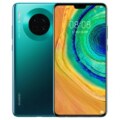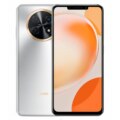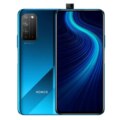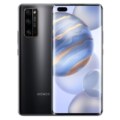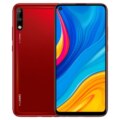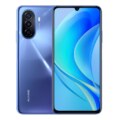- DroidAfrica
- Gadgets
- Huawei
- Honor Play 4T
Honor Play 4T

Honor Play 4T Highlights and Overview
Honor Play 4T is an affordable mobile phone from Huawei. It has the company’s home made CPU, and a dual cameras at the back. The phone come with a 6.39-inch display with 720 x 1560 pixels resolution. The display has a punch notch to the top left corner, where the selfie sensor is kept.
Under the hood, the Honor Play 4T runs on the HiSilicon Kirin 710A CPU. The Chip has a 2.2 GHz octa-core processor, pegged with Mali-G51 MP4 GPU. The CPU is assisted by a single option 6GB of RAM and 128GB of internal storage.
There are two camera modules at the back of the phone. The main sensor is a 48-megapixel unit with f/1.8 aperture and a single LED flash, pegged with a 2-megapixel depth lens. On the front, you are getting a single 8-megapixel shooter with AI beauty and FaceID.
Huawei’s 4T offers a rear-mounted fingerprint scanner, support dual Nano-SIM with 4G VoLTE network on both SIMs and available in Black, Blue and Green colors. The device is fueled by a 4000mAh battery, with 10W fast charger via micro USB 2.0 interface. Other things you would want to know about the Honor Play 4T are contained in the table below.
Honor Play 4T Full Specifications and Features
NETWORK
| Technology | GSM / CDMA / HSPA / LTE |
| 2G Network Bands |
GSM 850 / 900 / 1800 / 1900 - SIM 1 & SIM 2 CDMA 800 & TD-SCDMA |
| 3G Network Bands | HSDPA 850 / 900 / 1900 / 2100 |
| 4G Network Bands | LTE band 1(2100), 3(1800), 5(850), 8(900), 34(2000), 38(2600), 39(1900), 40(2300), 41(2500) |
| 5G Network Bands | Does not have support for 5G Network |
| Speed | HSPA 42.2/5.76 Mbps, LTE-A (2CA) Cat6 300/50 Mbps or LTE Cat4 150/50 Mbps |
LAUNCH
| Also Known As |
- - |
BODY
| Dimensions | 159.8 x 76.1 x 8.1 mm |
| Weight | 176 grams |
| Build |
Glass front - Plastic back, - Plastic frame |
| SIM Type | Dual SIM (Nano-SIM, dual stand-by) |
DISPLAY
| Display Type | IPS LCD capacitive touchscreen, 16M colors |
| Size | 6.39 inches, 100.2 cm2 (~82.4% screen-to-body ratio) |
| Resolution | 720 x 1560 pixels, 19.5:9 ratio (~269 ppi density) |
PLATFORM
| Operating System | Android 10.0 (AOSP + HMS); Magic UI 3.1 |
| Chipset | Huawei HiSilicon Kirin 710A (12 nm) |
| CPU | Octa-core (4x2.2 GHz Cortex-A73 & 4x1.7 GHz Cortex-A53) |
| GPU | Mali-G51 MP4 |
MEMORY
| RAM + ROM | 6 GB |
| Card Slot | microSDXC (uses shared SIM slot), up to 256GB |
MAIN CAMERA
| Camera Type | Double Lenses |
| Camera Sensor(s) | 48MP + 2 MP Main Camera Sensors |
| Camera Features |
Autofocus Continuous autofocus Continuous shooting Digital zoom Optical zoom Digital image stabilization Optical image stabilization Geotagging Panorama HDR Touch focus Face detection White balance settings ISO settings Exposure compensation Self-timer Scene mode Macro mode Sensor size - 1/1.7" Leica camera Vario Summilux-H Phase detection Laser autofocus Focal length (35 mm equivalent) - 27 mm 720p @ 960 fps Second sensor: 2 MP, f/2.4, depth sensor |
| Video Resolution | 1080p@30fps |
SELFIE CAMERA
| Camera Type | Single Lens |
| Camera Sensor(s) | 8-megapixel front-facing camera |
| Camera Features | Face Beautification |
| Video Resolution | 1080p@30fps |
SOUND
| Loudspeaker | Yes, |
| Speaker Location | Chin, below display |
| Audio Jack Type | Yes, 3.5mm audio jack |
CONNECTIVITY
| Bluetooth | Bluetooth 5.0, A2DP, LE |
| NFC | |
| GPS | Yes, with A-GPS, GLONASS, BDS |
| FM Radio | No |
BATTERY
| Battery Capacity | Non-removable Li-Po 4000 mAh battery |
| Wireless Charging | No |
| Talk Time Talk Time is the longest time that a single battery charge will last when you are constantly talking on the phone under perfect conditions, Ambient temperature and highly dependent on the cellular network environment such as the distance to the closest cell network tower. | Up to 29 hours |
| Stand-by | Up to 600 hours |
OTHER FEATURES
| Sensors | Fingerprint (side-mounted), accelerometer, proximity, compass |
| Box Contents | Charging Brick / USB cable |
Honor Play 4T User Reviews and Opinions
Disclaimer Note
We CANNOT guarantee 100% accuracy for the specification table above.

